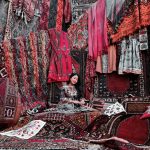It's no coincidence that as technology advances, so do the methods for digital fabric printing. You're probably aware of the incredible precision and resolution these techniques offer, but did you know about the versatility they bring to textile design? From direct-to-fabric printing to UV fabric printing, each method provides unique benefits and possibilities. You might find hybrid printing methods particularly intriguing, as they blend the best of digital and traditional techniques. Plus, with the rise of eco-friendly inks, the industry is evolving towards more sustainable practices. Let's explore how these advances are shaping the future of textile design.
Table of Contents
Key Takeaways
- High-Resolution Printing: Utilize advanced printheads for unparalleled precision and sharp details on various fabrics.
- UV Fabric Printing: Employ UV inks for vibrant, durable, and eco-friendly prints that cure instantly.
- Hybrid Printing Methods: Combine digital and traditional techniques for innovative designs and enhanced textures.
- Eco-Friendly Inks: Use water-based, soy-based, and algae inks for sustainable and high-quality printing solutions.
- AI-Powered Design Software: Leverage AI tools for efficient, customized, and on-demand fabric printing.
Direct-to-Fabric Printing
Direct-to-fabric printing, often referred to as DTG, allows you to print intricate designs directly onto textiles effortlessly. This technique is ideal for those seeking to achieve high levels of printing customization. DTG utilizes specialized inkjet technology, enabling you to create detailed patterns and vibrant imagery that traditional methods can't replicate. You'll value the precision and control this method offers, making it ideal for producing unique, one-of-a-kind pieces.
To excel in DTG printing, begin with proper fabric preparation. Ensuring your fabric is pre-treated correctly is essential for optimal ink adhesion. Without this step, even the most advanced printer won't deliver the desired results. Pre-treatment involves applying a special solution to the fabric, which helps the ink bond more effectively, ensuring your designs are vivid and long-lasting.
When emphasizing color vibrancy, choose high-quality inks formulated specifically for DTG printing. These inks are developed to penetrate the fabric fibers deeply, resulting in rich, attention-grabbing colors. By focusing on both fabric preparation and ink quality, you can achieve superior results.
DTG printing's versatility and precision make it a potent tool for those dedicated to mastering textile design.
Sublimation Printing
Sublimation printing uses a heat transfer process to infuse dye directly into the fabric.
You'll find it's perfect for polyester and other synthetic materials.
This technique offers excellent color retention, ensuring your designs stay vibrant over time.
Heat Transfer Process
In the heat transfer process, vibrant designs are transferred onto fabric using heat and pressure. You start by printing your design onto transfer paper. This paper is then placed onto the fabric, and a heat press is used to apply the necessary temperature and pressure to transfer the design. The heat causes the dye on the transfer paper to turn into gas, which then permeates the fabric and solidifies, resulting in a permanent, vivid print.
To master this technique, you need to fine-tune the settings on your heat press. Different fabrics and inks require specific temperatures and pressures for best results. Here's a quick reference table to guide you:
| Fabric Type | Temperature (°C) | Pressure (PSI) |
|---|---|---|
| Polyester | 200 | 40 |
| Cotton | 180 | 50 |
| Nylon | 170 | 30 |
Pay attention to the quality of your transfer paper as well. High-grade paper guarantees that your designs are crisp and vibrant.
Suitable Fabric Types
When selecting fabrics for sublimation printing, choose materials with high polyester content to guarantee the best outcomes. Polyester fibers have a natural affinity for the sublimation dyes, ensuring superior fabric durability and exceptional printing quality.
You'll find that synthetic fabrics provide the most vibrant colors and hold up well after multiple washes.
To achieve the best results, consider the following fabric options:
- Polyester: Pure polyester fabrics are ideal due to their excellent color vibrancy and wash fastness. They secure your designs remain vivid and durable.
- Polyester Blends: Fabrics with at least 65% polyester content can also work well, offering a good balance between print quality and fabric durability.
- Polyester Microfiber: This type of fabric is known for its smooth texture, which can enhance the sharpness of your printed designs.
- Polyester-Spandex: This blend provides flexibility and stretch while maintaining vibrant prints, perfect for activewear.
- Polyester-Fleece: Ideal for creating cozy, printed garments with high color retention and softness.
Color Retention Benefits
Selecting the right fabric not only impacts print quality but also plays a significant role in color retention, guaranteeing your designs remain vibrant through multiple washes. Sublimation printing excels in this area due to its unique process. The ink becomes a gas and bonds with the fibers of the fabric, creating a permanent, high-definition print. This leads to unmatched color vibrancy that withstands the test of time.
You'll appreciate the longevity benefits of sublimation printing, especially when paired with the correct fabric care tips. Choose polyester or polyester-blend fabrics, as these materials are ideal for holding sublimated dyes. To maximize color retention, wash the garments inside out with cold water and avoid harsh detergents.
Incorporating proper maintenance practices is essential. Air drying your sublimated fabrics rather than using a dryer can further preserve the vibrancy of your designs. By following these guidelines, you optimize that your printed fabrics maintain their brilliance and durability.
Mastering these techniques will enable you to produce high-quality, long-lasting prints that leave a lasting impression, setting your work apart in the competitive world of digital fabric printing.
Reactive Dye Printing
Have you ever wondered how reactive dye printing achieves such vibrant and long-lasting colors on fabric? The secret lies in its exceptional color fastness and fiber compatibility. Reactive dyes form a covalent bond with cellulose fibers, such as cotton, allowing the dye to become part of the fabric itself. This chemical reaction guarantees that the colors are incredibly durable and resistant to fading.
To master reactive dye printing, consider these pivotal points:
- Pre-treatment: Properly preparing the fabric is essential. Pre-treat with a solution that includes alkali and urea to ensure the dye reacts effectively.
- Dye Selection: Choose the appropriate reactive dyes that match the type of fiber you're working with. Cotton and other cellulose fibers are ideal candidates.
- Fixation: Use either steam or heat to fix the dye onto the fabric permanently. This step is necessary for achieving maximum color fastness.
- Washing: Post-printing washout is crucial to remove any unfixed dye, preventing color bleeding.
- Sustainability: Opt for low-impact reactive dyes to reduce environmental impact while maintaining high-quality prints.
Pigment Printing
When you delve into pigment printing, you'll concentrate on the distinctive composition of pigment inks and the specific steps in the printing process. Pigment inks contain fine particles that sit on the fabric's surface, producing vibrant colors.
Understanding each step in the printing process guarantees you achieve the best results with this technique.
Pigment Ink Composition
Pigment ink, an essential element in pigment printing, consists of finely crushed color particles suspended in a liquid carrier. This composition guarantees that the ink offers excellent ink durability and compatibility with a variety of fabrics.
To achieve best results, you must pay close attention to the fabric surface preparation and treatment. Properly treated fabrics enhance the adherence of pigment ink, resulting in vibrant and long-lasting prints.
When selecting pigment inks, consider the following essential aspects:
- Particle Size: Finer particles lead to smoother prints and finer detail resolution.
- Binder Type: Choose binders that enhance the ink's adhesion and flexibility.
- Carrier Liquid: The liquid should be stable and ensure uniform distribution of pigments.
- Ink Viscosity: Proper viscosity guarantees smooth flow through the print head.
- Color Fastness: Guarantee the ink provides resistance to washing and UV light.
Printing Process Steps
To achieve high-grade prints, you must follow a series of meticulously planned steps in the pigment printing process. First, make sure your fabric is pre-treated to enhance pigment adhesion. This step is essential for achieving vibrant colors and long-lasting prints.
Next, prepare your design using the latest design trends and printing techniques. High-resolution designs are vital for capturing intricate details. Once your design is ready, load it into the digital printer. Make sure to calibrate the printer settings according to the fabric type for best results.
During printing, maintain a consistent fabric tension to avoid any distortions. The pigment ink is applied directly onto the fabric, allowing for unparalleled fabric customization. This makes it perfect for artistic applications where precision is important.
After printing, the fabric needs to be dried and cured. Curing is typically done using heat, which helps set the pigment into the fibers, ensuring durability. Finally, conduct a quality check to make sure the print meets your high standards.
UV Fabric Printing
UV fabric printing offers a unique method that uses ultraviolet light to cure inks directly onto the fabric, resulting in vibrant and durable designs. With UV ink benefits, you'll enjoy a print that's not only striking but also resistant to fading and wear. This technique opens up innovative applications, perfect for creating intricate patterns on everything from fashion textiles to home décor.
Embracing UV fabric printing also supports sustainable practices. The process reduces waste since it requires less ink and eliminates the need for water-based washes. Consequently, it has a lower environmental impact compared to traditional printing methods. As you master UV fabric printing, you'll appreciate how it combines efficiency with eco-friendliness.
Consider these key points about UV fabric printing:
- Vivid Colors: UV inks produce exceptionally bright and bold colors that remain consistent over time.
- Quick Curing: The UV light instantly cures the ink, speeding up the production process.
- Versatility: Suitable for various fabrics, including synthetics and blends.
- Durability: UV-cured prints are resistant to scratches, chemicals, and outdoor conditions.
- Eco-Friendly: Reduced ink usage and no water waste contribute to a greener printing solution.
Hybrid Printing Methods
In the field of textile printing, hybrid printing methods combine the strengths of multiple techniques to deliver unparalleled results. By leveraging hybrid technology, you can achieve innovative designs that are both intricate and vibrant. This approach allows you to integrate the best aspects of digital and traditional printing methods, ensuring that each piece stands out with exceptional quality.
Imagine blending the precision of digital printing with the tactile richness of screen printing. Hybrid technology enables you to do just that. You can use digital printers for high-resolution images and intricate patterns, while screen printing can add textures and special effects that digital alone can't achieve. This synergy not only enhances the visual appeal but also the feel of your fabrics.
With hybrid printing, you're not limited by the constraints of a single method. You can experiment with different techniques to create unique, custom designs that meet the highest standards of quality and creativity. Whether you're aiming for bold, vibrant patterns or subtle, textured nuances, hybrid printing methods offer the flexibility and innovation needed to push the boundaries of textile design.
Embrace this cutting-edge technology to transform your creative visions into reality.
Eco-Friendly Inks
As you explore the innovative world of hybrid printing, it's equally important to ponder the impact of eco-friendly inks on your designs and the environment. Embracing sustainable practices not only enhances your creative output but also reduces the ecological footprint.
Ink sustainability has become a pivotal aspect of modern printing techniques, offering you a variety of environmentally conscious ink options.
Consider these eco-friendly ink choices to elevate your printing projects:
- Water-Based Inks: These are free from harmful chemicals and produce vibrant colors without compromising the environment.
- Soy-Based Inks: Made from renewable resources, these inks are biodegradable and offer excellent print quality.
- UV Inks: Cured using ultraviolet light, they minimize waste and energy consumption, making them a green choice.
- Algae Inks: Derived from algae cells, these inks are a sustainable alternative that reduces carbon footprint.
- Natural Dyes: Extracted from plants and minerals, they bring a unique, organic touch to your fabric designs.
Precision and Resolution
Achieving high precision and resolution in digital fabric printing ensures your designs come to life with sharp details and vibrant colors. You'll find that printing accuracy is crucial to ensuring every line, curve, and hue aligns perfectly with your creative vision. Leveraging advanced digital technology, you can manipulate fabric in ways that were once unimaginable, resulting in unparalleled image quality.
To master precision and resolution, you need to understand the role of high-definition printheads and the importance of selecting the right type of fabric. Not all fabrics respond equally to digital technology, and certain materials can hold finer details better. Mastery involves experimenting with different textiles to see which ones yield the best results.
Equally important is the calibration of your equipment. Ensuring your printer is finely tuned will greatly enhance printing accuracy. Consistent maintenance and software updates also contribute to maintaining excellent image quality.
Ultimately, precision and resolution in digital fabric printing aren't just about the tools you use but also your understanding of fabric manipulation. By combining the right digital technology with meticulous attention to detail, you can achieve prints that are both intricate and vibrant, setting a new standard in the world of fabric design.
Future Trends
Looking ahead, digital fabric printing is poised to revolutionize the textile industry with innovations that promise even greater precision and customization. You'll see sustainability impact and design innovation take center stage, driving the future of fabric printing. The market demand for eco-friendly solutions will push manufacturers to adopt greener practices, reducing waste and conserving resources.
Customization trends are set to soar, allowing you to offer highly personalized designs that cater to individual preferences. This not only meets consumer demands but also opens up new avenues for creative expression. The technological advancements will enable faster production cycles without compromising on quality.
Imagine leveraging these future trends to stay ahead in the game:
- Eco-conscious inks and materials: Reduce environmental impact with sustainable options.
- AI-powered design software: Enhance creativity and precision in your design process.
- On-demand printing services: Meet market demand efficiently with minimal inventory.
- Intelligent textiles: Integrate functionality and aesthetics seamlessly.
- Enhanced color management systems: Achieve consistent and vibrant results across different fabric types.
Embracing these advancements guarantees you remain at the forefront of the industry, offering unmatched quality and innovation. The future of digital fabric printing isn't just promising; it's transformative.
Frequently Asked Questions
How Does Fabric Type Influence the Choice of Digital Printing Technique?
When selecting a digital printing technique, you need to take into account fabric type because it affects color accuracy and fabric drape. Different fabrics also influence design complexity and print resolution, ensuring your final product meets high standards.
What Are the Primary Cost Considerations for Digital Fabric Printing?
When you consider the primary cost factors, think of them as an investment in artistry. Prioritize cost efficiency, environmental impact, and production speed while ensuring material quality. These elements shape your journey towards digital printing mastery.
How Do Digital Fabric Prints Fare in Terms of Durability and Washability?
You'll find digital fabric prints excel in color fastness and longevity. Proper maintenance and following care instructions are essential for preserving their quality, ensuring your prints remain vibrant and durable through numerous washes.
What Software Is Best for Designing Patterns for Digital Fabric Printing?
Did you know 70% of designers prefer Adobe Illustrator for pattern creation? It's the go-to graphic design tool for excellent color management. Explore other textile design software like CorelDRAW for versatile graphic design and seamless pattern creation.
Can Digital Fabric Printing Techniques Be Used for Small Batch Production?
You can absolutely use digital fabric printing techniques for small batch production. They offer excellent customization options and scalability. You'll also benefit from production efficiency, meeting market demand swiftly and effectively. Perfect for mastering niche markets.
- Advanced Tie-Dye Patterns and How to Make Them - July 13, 2025
- DIY Tie-Dye Techniques for Hoodies and Sweatshirts - July 13, 2025
- How to Tie-Dye T-Shirts: Top 5 Techniques - July 13, 2025







